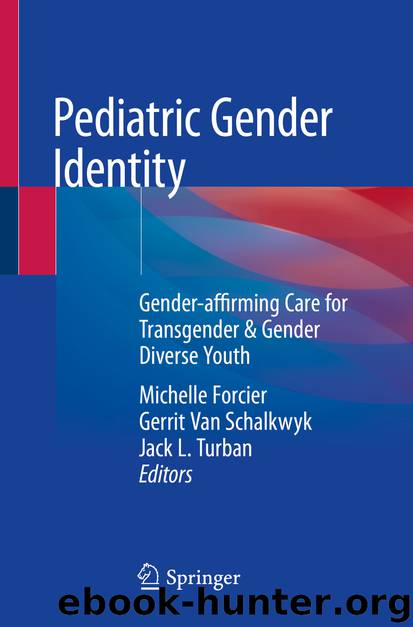Pediatric Gender Identity by Unknown

Author:Unknown
Language: eng
Format: epub
ISBN: 9783030389093
Publisher: Springer International Publishing
Co-occurrence
A growing body of literature suggests that neurodiversity and GD/TGD intersect more frequently than might be anticipated by chance. Existing literature has for the most part framed this as a categorical question, attempting to quantify rates of co-occurrence of GD and ASD. Studies have differed in the methods used (both qualitative and quantitative), the samples investigated (TGD individuals and individuals with ASD, respectively), and the use of control groups. The literature with regard to the co-occurrence of GD and ASD in children and adolescents was first described in several case reports [e.g., 3, 11]. The first quantitative study was a Dutch study that examined ASD in children and adolescents consecutively referred to a gender clinic by formally assessing an ASD diagnosis, using the Diagnostic Interview for Social and Communication Disorder [12]. An ASD incidence of 7.8% was found (n = 16 meeting the full criteria of ASD out of a total of N = 204) [4]. Other quantitative studies investigated the characteristics of ASD instead of ASD diagnoses in TGD children and adolescents [13–19]. These studies included sample sizes ranging from 25 to 490 TGD children and adolescents. Using different measures, such as the Social Responsiveness Scale [15, 17] or the Asperger Syndrome Diagnostic Scale [18], while using neurotypical [e.g., 13] or ASD reference groups [19], all studies that investigated clinical range ASD percentages found increased percentages of individuals that met the cut-off for a potential ASD diagnosis ranging from 14.5% to 68%. It should be noted, however, that none of these studies used a clinical control group, and therefore, general conclusions about these studies should be made carefully [20].
Conversely, one study investigated GD diagnoses in children with ASD [21]. This study found that children with ASD were over four times as likely to be diagnosed with GD, compared to children from the general population. In addition, four studies investigated gender variance (GV), defined as the wish to be of the other gender, in samples of children and adolescents diagnosed with ASD [22–25]. They found elevated levels of GV compared to the general population, with percentages ranging from 4% to 6.5%. One study also found increased levels of GV in individuals with attention-deficit/hyperactivity disorder [24], and therefore, any conclusions about the specificity of these findings should be made with caution. One recent study investigated TGD and ASD in a community-based general population sample of children and found that increased ASD characteristics were associated with increased TGD characteristics [26].
Although the literature strongly points out a more frequent intersection of TGD and neurodiversity, some additional conceptualizations are relevant. Diagnosing ASD properly can be challenging, even more so in clinic-referred youth. In general, more research with validated measures is necessary to investigate the co-occurring prevalence rates. Also, the social cognitive challenges that have been found in TGD youth might represent a distinct phenomenon from ASD; TGD individuals might score higher on social cognitive measures due to a high prevalence of minority stress and poor peer relations, instead of reflecting an ASD diagnosis [20].
Download
This site does not store any files on its server. We only index and link to content provided by other sites. Please contact the content providers to delete copyright contents if any and email us, we'll remove relevant links or contents immediately.
International Integration of the Brazilian Economy by Elias C. Grivoyannis(57364)
The Radium Girls by Kate Moore(10914)
Turbulence by E. J. Noyes(7049)
Nudge - Improving Decisions about Health, Wealth, and Happiness by Thaler Sunstein(6641)
The Black Swan by Nassim Nicholas Taleb(6201)
Pioneering Portfolio Management by David F. Swensen(5611)
Rich Dad Poor Dad by Robert T. Kiyosaki(5157)
Zero to One by Peter Thiel(4832)
Man-made Catastrophes and Risk Information Concealment by Dmitry Chernov & Didier Sornette(4746)
Secrecy World by Jake Bernstein(3787)
Millionaire: The Philanderer, Gambler, and Duelist Who Invented Modern Finance by Janet Gleeson(3574)
Skin in the Game by Nassim Nicholas Taleb(3476)
The Age of Surveillance Capitalism by Shoshana Zuboff(3429)
The Money Culture by Michael Lewis(3290)
Skin in the Game: Hidden Asymmetries in Daily Life by Nassim Nicholas Taleb(3270)
Bullshit Jobs by David Graeber(3183)
The Dhandho Investor by Mohnish Pabrai(3173)
The Wisdom of Finance by Mihir Desai(3083)
Blockchain Basics by Daniel Drescher(2895)
